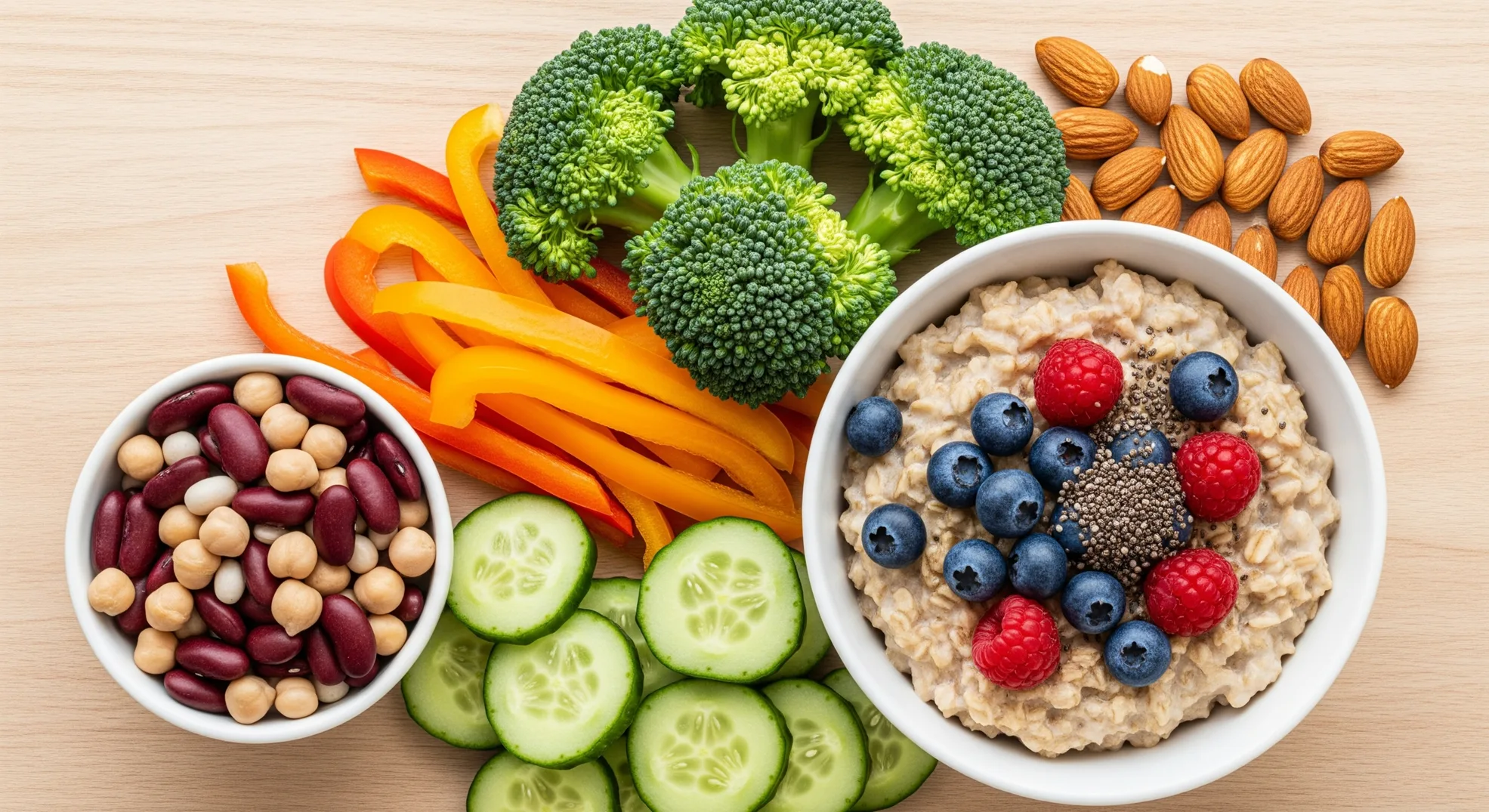Managing diabetes can often feel like a complicated balancing act, especially when it comes to your diet. But what if one of the most powerful tools for better blood sugar control wasn’t about restriction, but about adding something incredibly beneficial to your plate? Enter dietary fiber—the unsung superhero of diabetes management. Incorporating a variety of High-Fiber Foods for Diabetes into your daily routine can be a game-changer, helping you stabilize blood sugar, stay full longer, and improve your overall health.
This guide is your ultimate resource for harnessing the power of fiber. We’ll break down why this nutrient is so crucial and count down the top 20 delicious, versatile, and fiber-packed foods. Get ready to discover how adding these foods to your diet can make managing diabetes easier and more delicious than ever before.
Why is Fiber a Game-Changer for Diabetes?
Fiber is a type of carbohydrate that your body can’t digest. Instead of being broken down into sugar molecules, it passes through your system largely intact. This unique characteristic is what makes it so incredibly beneficial for people with diabetes.
The Two Types of Fiber: Soluble and Insoluble
First, it’s helpful to know that there are two main types of fiber, and both are important.
- Soluble Fiber: This type dissolves in water to form a gel-like substance in your digestive tract. This gel slows down digestion, which is key for blood sugar management.
- Insoluble Fiber: This type does not dissolve in water. It adds bulk to your stool and helps food pass more quickly through the stomach and intestines, promoting regularity.
Fiber’s Direct Impact on Blood Sugar Control
The primary benefit of fiber for diabetes management comes from its ability to slow down the absorption of sugar into the bloodstream. When you eat a meal rich in soluble fiber, the gel it forms acts like a buffer, preventing the rapid spike in blood glucose that can occur after eating carbohydrates. According to the American Diabetes Association, this slowing effect leads to more stable blood sugar levels, which is a cornerstone of effective diabetes management.
Beyond Blood Sugar: Other Benefits of Fiber
The advantages don’t stop there. High-fiber foods are typically more filling, helping you feel satisfied with smaller portions, which can aid in weight management. Furthermore, soluble fiber can help lower LDL (“bad”) cholesterol levels, supporting heart health—a critical consideration for anyone with diabetes.
The 20 Best High-Fiber Foods for Diabetes
Ready to fill your cart? Here are 20 fantastic, high-fiber foods to add to your grocery list, broken down by category.
Legumes: The Undisputed Champions of Fiber
Legumes are a perfect package of fiber, plant-based protein, and slow-digesting carbohydrates.
- Lentils: A true superstar, lentils are packed with both soluble fiber and protein. They are inexpensive, versatile, and incredibly satisfying.
- Easy Tip: Make a large batch of our Hearty Lentil Soup Recipe for easy, healthy meals throughout the week.
- Chickpeas (Garbanzo Beans): With their nutty flavor and firm texture, chickpeas are a fantastic addition to salads, soups, and stews.
- Easy Tip: Roast them with spices for a crunchy, high-fiber snack, or blend them into a creamy hummus.
- Black Beans: A staple in many cuisines, black beans are loaded with fiber, potassium, and protein.
- Easy Tip: Add a can of rinsed black beans to your favorite salad, taco filling, or chili.
- Kidney Beans: These robust beans hold their shape well in cooking, making them perfect for slow-cooked dishes.
- Easy Tip: They are the classic choice for a hearty, diabetes-friendly chili.
Non-Starchy Vegetables: Nutrient-Dense and Low-Carb
These veggies offer a huge nutritional bang for very few carbohydrates.
- Broccoli: This cruciferous vegetable is not only high in fiber but also in vitamin C and sulforaphane, a powerful antioxidant.
- Easy Tip: Roast broccoli florets with a little olive oil, garlic, and a pinch of salt until tender-crisp.
- Brussels Sprouts: Another member of the cruciferous family, Brussels sprouts are packed with fiber and nutrients.
- Easy Tip: Cut them in half, toss with olive oil, and cook them in an air fryer for a crispy, irresistible side dish. Learn more about this method in Air Fryer Magic.
- Avocado: Unique among fruits, avocados are low in sugar and loaded with healthy monounsaturated fats and an impressive amount of fiber.
- Easy Tip: Add slices of avocado to sandwiches, salads, or scrambled eggs for a creamy, satisfying boost.
- Leafy Greens (Spinach & Kale): These greens are nutritional powerhouses, offering fiber, vitamins, and minerals for almost zero calories or carbs.
- Easy Tip: Wilt a large handful of spinach or kale into soups, stews, or pasta sauces.
- Artichokes: Artichokes are one of the most fiber-dense vegetables you can find.
- Easy Tip: Steam a whole artichoke and dip the leaves in a lemon-garlic butter, or add canned artichoke hearts to salads and pizzas.
Fruits: Nature’s Sweet and Fibrous Treat
While fruits contain natural sugar, many are also packed with fiber, which helps slow its absorption.
- Berries (especially Raspberries & Blackberries): Berries are the fiber superstars of the fruit world. They are relatively low in sugar and packed with antioxidants.
- Easy Tip: Top your morning oatmeal or Greek yogurt with a cup of mixed berries.
- Pears: A medium-sized pear, with the skin on, provides a significant amount of fiber.
- Easy Tip: Simply eat a whole pear as a snack.
- Apples: Like pears, the skin of an apple is where much of the insoluble fiber is found.
- Easy Tip: An apple sliced and paired with a tablespoon of peanut or almond butter is a classic, balanced snack. For more ideas, check out our guide to Smart Snacking for Diabetes.
- Oranges: Eating a whole orange provides fiber that you miss out on when you drink orange juice.
Whole Grains: Smart Carbs for Stable Energy
Choose whole grains over refined grains to get the full fiber benefit.
- Oats: Oats contain a specific type of soluble fiber called beta-glucan, known for its positive effects on blood sugar and cholesterol.
- Easy Tip: Choose steel-cut or old-fashioned rolled oats for the highest fiber content.
- Quinoa: This popular seed is technically not a grain, but it’s cooked and eaten like one. It’s a complete protein and a great source of fiber.
- Easy Tip: Use it as a base for a Sumptuous Quinoa and Roasted Vegetable Salad.
- Barley: This chewy, nutty grain is excellent in soups, stews, and risotto-style dishes.
- Farro: An ancient wheat grain that’s making a comeback, farro has a satisfying chew and is rich in fiber and protein.
Nuts and Seeds: Small but Mighty
These are concentrated sources of fiber, protein, and healthy fats.
- Chia Seeds: These tiny seeds are incredibly high in soluble fiber. When mixed with liquid, they form a gel, making them great for thickening.
- Easy Tip: Make a simple chia seed pudding by mixing 2 tablespoons of seeds with ½ cup of almond milk. Let it sit for a few hours or overnight.
- Flaxseeds: To get the full benefit, consume flaxseeds ground. They are a great source of both soluble fiber and omega-3 fats.
- Easy Tip: Add a tablespoon of ground flaxseed to your morning smoothie or sprinkle it over yogurt.
- Almonds: A small handful of almonds makes for a crunchy, satisfying snack that provides a good dose of fiber and protein.
Practical Tips for Increasing Your Fiber Intake
- Start Slow: If your diet is currently low in fiber, increase your intake gradually over a few weeks to allow your digestive system to adjust.
- Drink Plenty of Water: Fiber works best when it absorbs water. Be sure to stay well-hydrated throughout the day. Our guide, Why Hydration is Important for Diabetes, explains this in more detail.
- Read Labels: Get into the habit of checking the “Dietary Fiber” content on nutrition labels. This skill, explored in Decoding Food Labels, can help you make smarter choices.
- Make Simple Swaps: One of the easiest ways to boost fiber is through simple substitutions. Try some Smart Carb Swaps for a Diabetes-Friendly Diet like choosing whole-wheat bread over white bread or brown rice over white rice.
Incorporating these High-Fiber Foods for Diabetes into your diet is a delicious and empowering way to take charge of your health. It’s not about a restrictive diet, but rather a flavorful journey towards better blood sugar control and a healthier you.
Check out the author’s book here: Diabetic Air Fryer Cookbook.


Leave a Reply